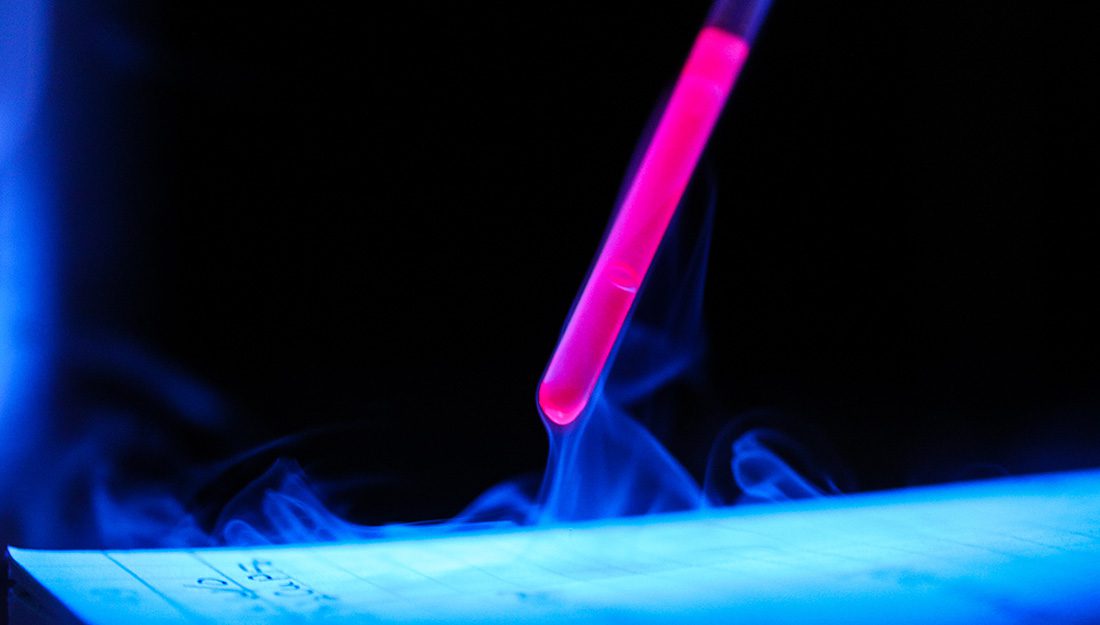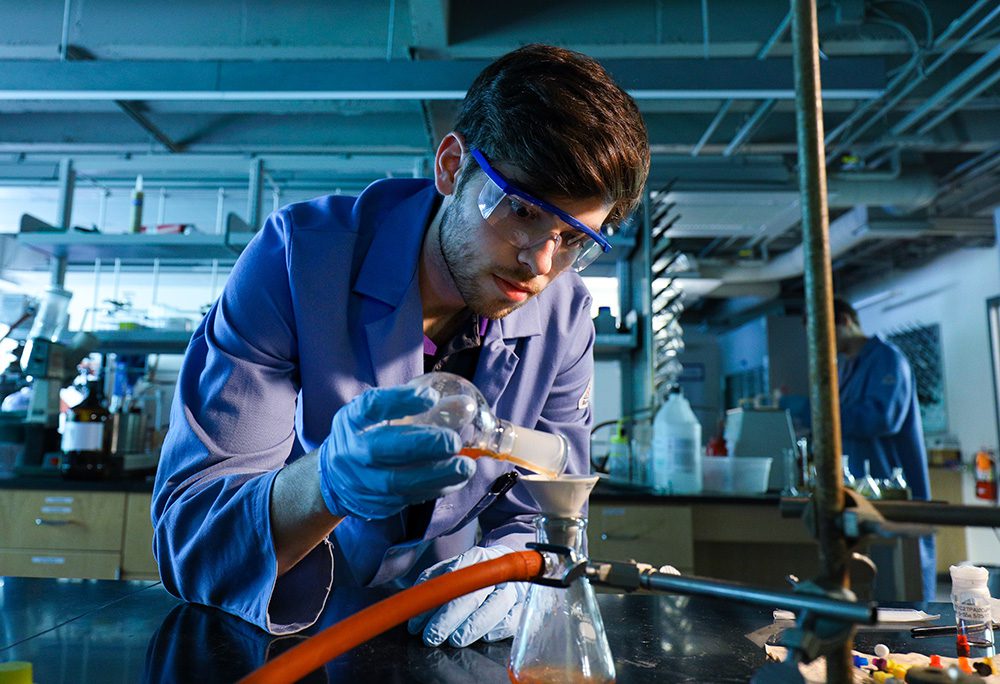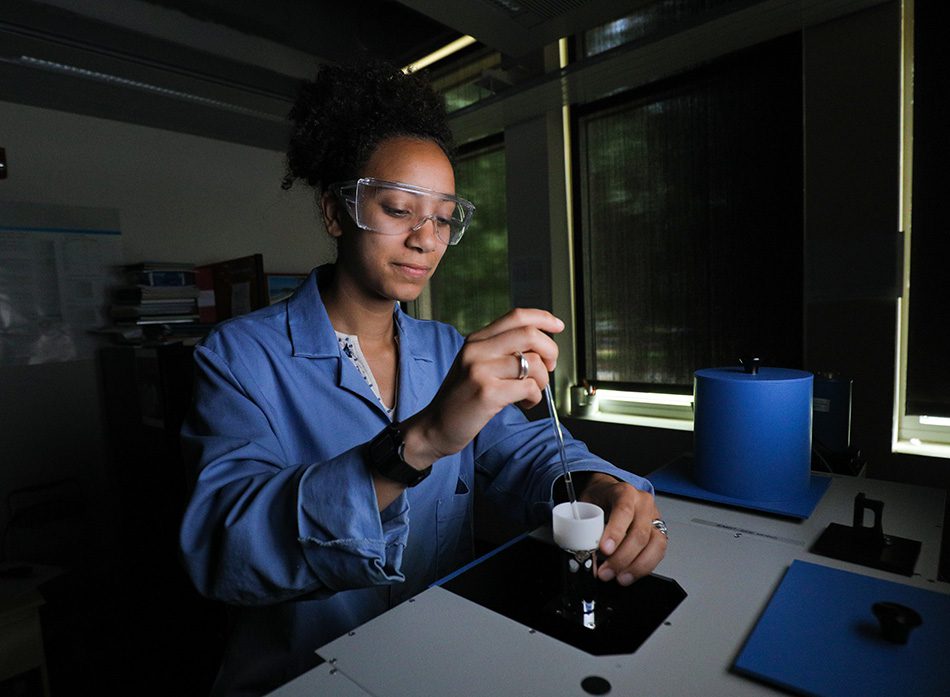Shaping the future of solar

If lab work takes classroom theory and applies it, then a conference takes lab work and places it firmly in the real world.
Two Furman students traveled to Oxford this month and experienced that real-world connection as they shared their research with experts in the field of photochemistry.
Alexis Myers ’18 and Noah Vieira ’19, attended the 22nd International Symposium on the Photophysics and Photochemistry of Coordination Compounds with Paul Wagenknecht ’86, Herman N. Hipp Professor of Chemistry. Wagenknecht frequently attends this biennial conference. Vieira and Myers are the third and fourth students he’s taken with him.
This year’s conference hosted about 250 people from more than 30 countries. Roughly half of the attendees were faculty. Myers and Vieira were two of the three undergrads in attendance.

Noah Vieira uses vacuum filtration to isolate one of the new compounds that he has synthesized.
“It’s really cool to be able to contribute to that community and figure out things that students might be able to learn down the road,” Vieira said.
Their research is connected to technology for converting solar energy to electric energy. Special dye-sensitized solar cells have been developed to make solar panels works of art—almost like stained glass—instead of the traditional dark panels typically seen in fields and on roofs.
The colored panels are already in use as decorative building features or in public art. But an element of the dye that’s in them is too scarce for wide use. Wagenknecht and his students are working on dyes that would be more flexible and less expensive while still possessing the appropriate electronic characteristics.
“The game is, you’ve got to test a lot of stuff to find one,” Wagenknecht said. “We found a class that we think has the right characteristics.”
Myers and Vieira presented their work in a poster session at the conference. Wagenknecht said it was the highwater moment of the conference for him, watching them field questions and engage about their ideas.
“They went toe to toe with the world’s experts in this area,” he said.
There was broad interest in their work—they hardly had time for a sip of water during the session.
“Everyone seemed to really value what we were talking about,” Vieira said. “It was really well received and people were interested.”
Myers hadn’t anticipated their work being novel to many of the attendees. The structure of the molecules that the Furman team is working on falls outside the normal paradigm for this kind of research.
“To have them be, like, ‘Good on you guys,’ was very fulfilling,” she said.
Vieira, a Beckman Research Scholar, unlocked one piece of information during his work in summer 2016.
He found that an atom of copper could insert itself into some of the dyes the team was testing. The copper stabilized the dyes to light while maintaining their other necessary properties. The binding site on the molecule is the paradigm shift in the Furman team’s research.
“Why is it stable?” Wagenknecht said. “Maybe we can continue to use that new-found stability, but only if we can understand it. If you don’t know why, all you’re doing is taking shots in the dark.”
Vieira is energized by what he’s learning.

Alexis Myers inserts one of her compounds into a fluorimeter to measure its phosphorescence at a temperature of -321F.
“You’re looking at things that no one’s really looked at before,” he said, “trying to solve problems that are already present in the world.”
Myers was ready to declare a chemistry major the first week of her freshman year.
“I want to have a job that has an impact on the world,” she said. “Doing research every summer prepares me more for the school year. We are actually making contributions to science.”
During the conference, they sat in on about six hours of talks and lectures each day and then spent two hours or more in poster sessions, studying others’ research. Myers felt comfortable and prepared to discuss their work. But the hours of talks were another story for her and Vieira.
“The conference as a whole was excellent for the future—to eventually understand more of what they’re saying,” she said with a laugh.
That might have discouraged her, if not for what her professor told her: “I only understand about half of what I hear,” Wagenknecht said.
Undergraduate research is one of the high-impact engaged learning opportunities provided through The Furman Advantage, and Wagenknecht wanted his students to come away from the experience with an appreciation for the breadth of their field, confidence in their own skills, excitement about science and awareness of the global aspect of the work. And that’s what happened.
“You gain a big appreciation for the overall way that these sorts of ideas we’re working on can have an impact on the world,” Vieira said.
Learn more about undergraduate research at Furman.